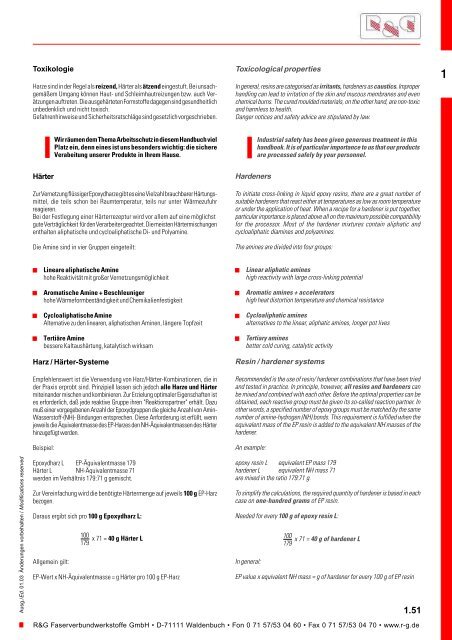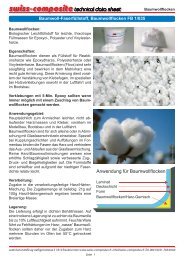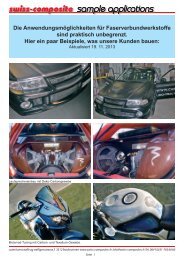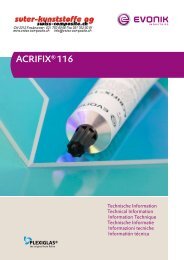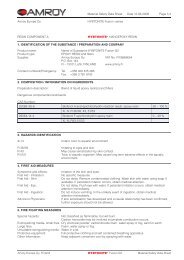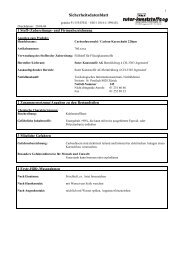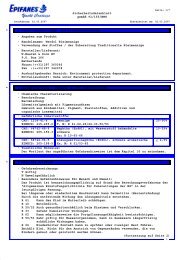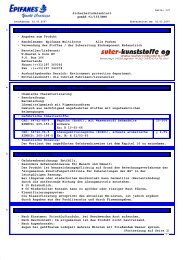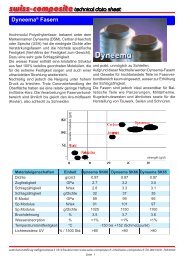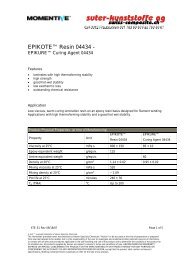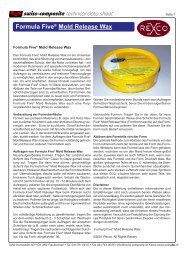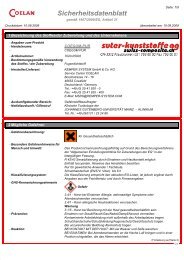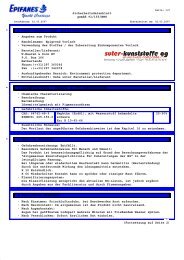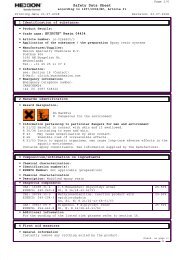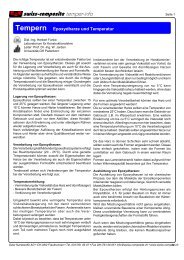Handbuch - Suter Swiss-Composite Group
Handbuch - Suter Swiss-Composite Group
Handbuch - Suter Swiss-Composite Group
Sie wollen auch ein ePaper? Erhöhen Sie die Reichweite Ihrer Titel.
YUMPU macht aus Druck-PDFs automatisch weboptimierte ePaper, die Google liebt.
Ausg./Ed. 01.03 Änderungen vorbehalten / Modifications reserved<br />
Toxikologie<br />
Harze sind in der Regel als reizend, Härter als ätzend eingestuft. Bei unsachgemäßem<br />
Umgang können Haut- und Schleimhautreizungen bzw. auch Verätzungen<br />
auftreten. Die ausgehärteten Formstoffe dagegen sind gesundheitlich<br />
unbedenklich und nicht toxisch.<br />
Gefahrenhinweise und Sicherheitsratschläge sind gesetzlich vorgeschrieben.<br />
Härter<br />
Wir räumen dem Thema Arbeitsschutz in diesem <strong>Handbuch</strong> viel<br />
Platz ein, denn eines ist uns besonders wichtig: die sichere<br />
Verabeitung unserer Produkte in Ihrem Hause.<br />
Zur Vernetzung flüssiger Epoxydharze gibt es eine Vielzahl brauchbarer Härtungsmittel,<br />
die teils schon bei Raumtemperatur, teils nur unter Wärmezufuhr<br />
reagieren.<br />
Bei der Festlegung einer Härterrezeptur wird vor allem auf eine möglichst<br />
gute Verträglichkeit für den Verarbeiter geachtet. Die meisten Härtermischungen<br />
enthalten aliphatische und cycloaliphatische Di- und Polyamine.<br />
Die Amine sind in vier Gruppen eingeteilt:<br />
Lineare aliphatische Amine<br />
hohe Reaktivität mit großer Vernetzungsmöglichkeit<br />
Aromatische Amine + Beschleuniger<br />
hohe Wärmeformbeständigkeit und Chemikalienfestigkeit<br />
Cycloaliphatische Amine<br />
Alternative zu den linearen, aliphatischen Aminen, längere Topfzeit<br />
Tertiäre Amine<br />
bessere Kaltaushärtung, katalytisch wirksam<br />
Harz / Härter-Systeme<br />
Empfehlenswert ist die Verwendung von Harz/Härter-Kombinationen, die in<br />
der Praxis erprobt sind. Prinzipiell lassen sich jedoch alle Harze und Härter<br />
miteinander mischen und kombinieren. Zur Erzielung optimaler Eigenschaften ist<br />
es erforderlich, daß jede reaktive Gruppe ihren "Reaktionspartner" erhält. Dazu<br />
muß einer vorgegebenen Anzahl der Epoxydgruppen die gleiche Anzahl von Amin-<br />
Wasserstoff-(NH)- Bindungen entsprechen. Diese Anforderung ist erfüllt, wenn<br />
jeweils die Äquivalentmasse des EP-Harzes den NH-Äquivalentmassen des Härter<br />
hinzugefügt werden.<br />
Beispiel:<br />
Epoxydharz L EP-Äquivalentmasse 179<br />
Härter L NH-Äquivalentmasse 71<br />
werden im Verhältnis 179:71 g gemischt.<br />
Zur Vereinfachung wird die benötigte Härtermenge auf jeweils 100 g EP-Harz<br />
bezogen.<br />
Daraus ergibt sich pro 100 g Epoxydharz L:<br />
Allgemein gilt:<br />
100<br />
x 71 = 40 g Härter L<br />
179<br />
EP-Wert x NH-Äquivalentmasse = g Härter pro 100 g EP-Harz<br />
Toxicological properties<br />
In general, resins are categorised as irritants, hardeners as caustics. Improper<br />
handling can lead to irritation of the skin and mucous membranes and even<br />
chemical burns. The cured moulded materials, on the other hand, are non-toxic<br />
and harmless to health.<br />
Danger notices and safety advice are stipulated by law.<br />
Hardeners<br />
To initiate cross-linking in liquid epoxy resins, there are a great number of<br />
suitable hardeners that react either at temperatures as low as room temperature<br />
or under the application of heat. When a recipe for a hardener is put together,<br />
particular importance is placed above all on the maximum possible compatibility<br />
for the processor. Most of the hardener mixtures contain aliphatic and<br />
cycloaliphatic diamines and polyamines.<br />
The amines are divided into four groups:<br />
Linear aliphatic amines<br />
high reactivity with large cross-linking potential<br />
Aromatic amines + accelerators<br />
high heat distortion temperature and chemical resistance<br />
Cycloaliphatic amines<br />
alternatives to the linear, aliphatic amines, longer pot lives<br />
Tertiary amines<br />
better cold curing, catalytic activity<br />
Resin / hardener systems<br />
Recommended is the use of resin/ hardener combinations that have been tried<br />
and tested in practice. In principle, however, all resins and hardeners can<br />
be mixed and combined with each other. Before the optimal properties can be<br />
obtained, each reactive group must be given its so-called reaction partner. In<br />
other words, a specified number of epoxy groups must be matched by the same<br />
number of amine-hydrogen (NH) bonds. This requirement is fulfilled when the<br />
equivalent mass of the EP resin is added to the equivalent NH masses of the<br />
hardener.<br />
An example:<br />
epoxy resin L equivalent EP mass 179<br />
hardener L equivalent NH mass 71<br />
are mixed in the ratio 179:71 g.<br />
To simplify the calculations, the required quantity of hardener is based in each<br />
case on one-hundred grams of EP resin.<br />
Needed for every 100 g of epoxy resin L:<br />
In general:<br />
Industrial safety has been given generous treatment in this<br />
handbook. It is of particular importance to us that our products<br />
are processed safely by your personnel.<br />
100<br />
x 71 = 40 g of hardener L<br />
179<br />
EP value x equivalent NH mass = g of hardener for every 100 g of EP resin<br />
R&G Faserverbundwerkstoffe GmbH D-71111 Waldenbuch Fon 0 71 57/53 04 60 Fax 0 71 57/53 04 70 www.r-g.de<br />
1.51<br />
1


